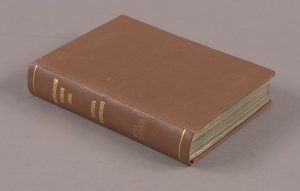By Erin Hammeke
We have two incunabula in the lab that illustrate the effects of unsympathetic rebinding, a practice that has played an unfortunate role in the history of repair and maintenance of bookbindings. Both of these texts were printed in the early days of printing, in the year 1501.
 |
 |
(Above) Grãmatica Nocolai Perotti… was printed in Cologne and still sports an early wooden board binding with blind tooled, tawed-skin covering and brass clasp. This binding may have been its original binding or was likely made not too long after the text’s printing. The insides of the wooden boards display manuscript waste fragments and an untrimmed text. Despite a large loss to a portion of the textblock, the binding remains functional and protected by an enclosure and careful handling.
 |
 |
(Above) Baptistae Mantuani poetae oratorisq[ue]… printed in Strasbourg in the same year, faced a very different fate and was rebound in the 20th century in a buckram-covered case binding with modern endpapers. The pages appear to have been pressed very flat, removing all type impression; the textblock has been oversewn; and the pages have been trimmed so much that marginalia has been cut.
Examples like these remind us of the value of the original and what information may be lost when we make things “new and improved.”

